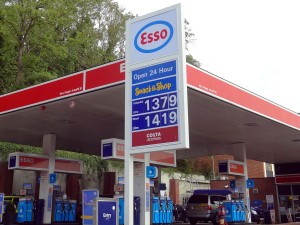 When crude oil prices go up, the prices of petrol and diesel go up pretty well straight away and by the full amount, or more, of the crude price rise. When crude prices go down, however, road fuel prices are often slow to fall; and when they do, the fall is less than the full fall in crude prices.
When crude oil prices go up, the prices of petrol and diesel go up pretty well straight away and by the full amount, or more, of the crude price rise. When crude prices go down, however, road fuel prices are often slow to fall; and when they do, the fall is less than the full fall in crude prices.
Click on charts below for a larger version. Click here for a PowerPoint of the left-hand chart.
In response to complaints of motorists and haulage companies, the Office of Fair Trading has announced that it will investigate the link between crude prices and prices at the pump. It will report in January 2013.

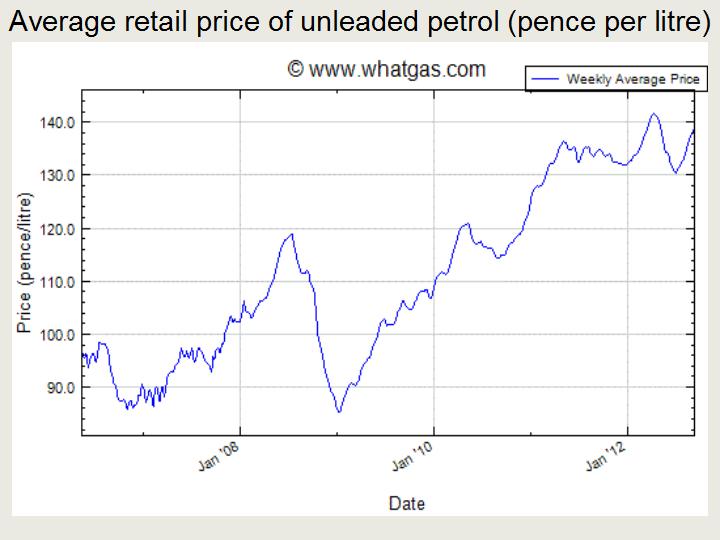
The review will consider questions of competition and market power. In particular, it will look at the power of the oil companies in determining the wholesale price of road fuel.
It will also examine the retail fuel sector and whether supermarkets are driving out independent retailers. The claim of many independent petrol stations is that supermarkets are selling below cost as a lost leader to encourage people to shop in their stores. They also claim that supermarkets use their buying power to obtain fuel more cheaply.
What is more, most of the petrol stations that are not part of supermarkets are owned by the oil companies. Again, independents claim that oil companies supply fuel more cheaply to their own stations than to independents.
As a result of what many independents see as unfair competition, many are driven out of business. Today there some 9000 petrol stations in the UK; 20 years ago there were twice as many.
The following articles look at the remit of the OFT investigation and at the competition issues in the road fuel market.
Articles
 Formal inquiry tries to ease motorist pain at the pumps ITV News, Laura Kuenssberg (5/9/12)
Formal inquiry tries to ease motorist pain at the pumps ITV News, Laura Kuenssberg (5/9/12)
OFT to scrutinise retail petrol market Financial Times, Caroline Binham (5/9/12)
OFT launches probe into pump prices Channel 4 News (5/9/12)
Petrol and diesel prices: Office of Fair Trading launches competition inquiry Guardian, Terry Macalister (5/9/12)
Petrol and diesel price review is launched by OFT BBC News (5/9/12)
Are supermarkets to blame for the devastation of independent petrol retailers by deliberately selling at a loss? This is Money, Tom Mcghie and Neil Craven (8/9/12)
OFT petrol pricing probe welcomed The Grocer, Beth Phillips (7/9/12)
Private businesses welcome OFT’s fuel price investigation Talking Retail (6/9/12)
10 charges that make consumers scratch their heads BBC News Magazine, Lucy Townsend (6/9/12)
Data
Crude Oil Price Index Index Mundi
Daily Brent Crude Spot Price, 1987 to present day US Energy Information Administration
Current UK Petrol Pump Prices What Pric£?
Fuel Prices WhatGas.com
Questions
- Describe the structure of the road fuel market, from oil production through to the retailing of petrol and diesel.
- What is meant by the terms ‘monosony’ and ‘oligopsony’? Which companies in the road fuel market have significant monopsony/oligopsony power?
- What determines the price elasticity of demand for road fuel in (a) the short run; (b) the long run? What implications does this have for the value of the short-run and long-run price elasticities?
- Where is the abuse of market power likely to occour in the road fuel market?
- To what extent is it in the consumers’ interests for supermarkets to sell road fuel below average cost?
- Examine the data for pump prices and crude oil prices and establish whether there is any truth in the claim that pump prices adjust rapidly to a rise in crude prices and slowly to a fall in crude prices.
 Last year, an academic discovered that the only two firms on Amazon selling new copies of a classic biology textbook were charging well over $1 million (plus $3.99 for shipping!). Furthermore, when he checked the next day, prices had risen even further to nearly $2.8 million! Intrigued by this strange pricing behaviour, he started to investigate the prices further.
Last year, an academic discovered that the only two firms on Amazon selling new copies of a classic biology textbook were charging well over $1 million (plus $3.99 for shipping!). Furthermore, when he checked the next day, prices had risen even further to nearly $2.8 million! Intrigued by this strange pricing behaviour, he started to investigate the prices further.
In oligopoly markets with a small number of players, firms must make strategic decisions taking into account how they expect their rivals will react. One option in today’s online market places is for firms to use computer algorithms which automatically adjust their prices according to the prices their rivals are charging. The results of his investigation suggested that this was exactly what was causing the prices for this textbook to be so high.
One of the firms appeared to adopt a pricing rule which set its price at 0.9983 times the price of the other firm. This seems to make sense – this firm wants to undercut its rival in order to be more likely to sell its copy. However, if both firms operated under this strategy, we would expect to see prices falling over time (see also). In contrast, the strategy of the other firm appeared to be to price 1.270589 above its rival’s price. Why would it want to try to make sure it was always more expensive that its rival? The academic’s plausible explanation was that:
“…they do not actually possess the book. Rather, they noticed that someone else listed a copy for sale, and so they put it up as well – relying on their better feedback record to attract buyers. But, of course, if someone actually orders the book, they have to get it – so they have to set their price significantly higher – say 1.27059 times higher – than the price they’d have to pay to get the book elsewhere.”
Put both of these pricing rules together and prices will continuously rise over time! This was exactly what the academic observed for over a week, until human intervention appears to have returned prices to a more sensible level.
As Tim Harford discusses in his recent blog post, it had been hoped that online market places would result in very low prices because the high degree of price transparency increases competition. Clearly the prices Amazon was initially charging for the textbook didn’t support this theory and even after human intervention prices would seem to be well above marginal production costs. However, as the blog post goes on to explain, we should not necessarily expect price transparency always to lead to low prices. Economic theory shows us that in oligopoly markets, when a small number of players interact repeatedly, they may be able to collude tacitly on high prices. Furthermore, a high degree of price transparency may help such collusive behaviour because it makes it easier for firms to detect cheating by a rival.
Amazon’s $23,698,655.93 Book About Flies (SCREENSHOT) The Huffington Post, Steven Hoffer (26/04/11)
Questions
- What are the key features of competition between book sellers on Amazon?
- What price setting rule would the two firms have to use for prices to continuously fall over time? Provide an illustrative example.
- What are the pros and cons for a firm of relying on a computer algorithm to set its prices?
- How might a firm program its price setting algorithm if it wanted to collude tacitly with its rivals?
- Can you think of any other explanations for the pricing strategies that the two Amazon sellers adopted?
 In oligopoly markets, because there are a small number of firms, each firm is affected by its rivals’ decisions. This interdependence results in a tension between cooperation and competition. On the one hand, firms collectively benefit from cooperating and keeping prices high.
In oligopoly markets, because there are a small number of firms, each firm is affected by its rivals’ decisions. This interdependence results in a tension between cooperation and competition. On the one hand, firms collectively benefit from cooperating and keeping prices high.
On the other hand, an individual firm then has an incentive to undercut its rivals to steal a larger share of the market. This incentive to undercut can potentially result in price wars between firms. This is exactly what has recently occurred between pizza sellers on the Avenue of Americas in Midtown New York. Here, until recently the 6th Ave. Pizza company was selling pizza for $1.50 per slice. However, the entry of two competitors nearby sparked an intense and bitter price war.
First, an outlet called Joey Pepperoni’s Pizza opened nearby and charged $1 per slice. This price was then matched by the 6th Avenue Pizza company. Then, the 2 Bros. pizza chain opened an outlet almost next door to the 6th Avenue Pizza company. Initially, they also charged $1 per slice.
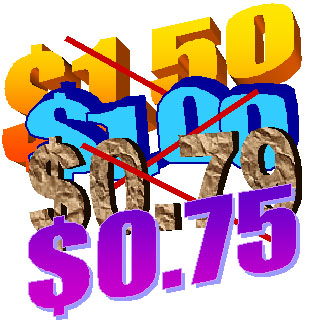 However, this did not last for too long. First 6th Avenue cut its price to 79 cents and then 2 Bros. responded by cutting its price to 75 cents, which 6th Avenue quickly matched.
However, this did not last for too long. First 6th Avenue cut its price to 79 cents and then 2 Bros. responded by cutting its price to 75 cents, which 6th Avenue quickly matched.
Which company started this price war has been subject to some debate. The owners of the 6th Avenue Pizza company were angry, alleging that 2 Bros. was trying to force them out of business. However, the owners of 2 Bros. claimed that they were simply responding to the 6th Avenue Pizza company’s decision to start charging 79 cents per slice and they even have evidence from their security cameras confirming this! When asked why they cut their price the owners of the 6th Avenue company said that:
He was taking away our customers. How were we going to pay our rent?
So what will happen next in this market? One of the owners of the 2 Bros. company has said that they will go back to $1 per slice if the 6th Avenue Pizza company does the same, as they can’t make any profit at the current price. However, the tension between cooperation and competition suggests this may be difficult to sustain.
In the meantime, both are quoted suggesting that they may be tempted to reduce prices even further. 6th Avenue Pizza company stated:
We may go to 50 cents. I want to hit him. I want to beat him.
2 Bros. said:
We might go to free pizza soon.
Of course, while the price war continues, the clear winners are the consumers. In the article one is quoted as saying:
I think it’s beautiful. We need 75-cent hamburgers next.
Articles
Questions
- Why is it difficult for firms to maintain high prices in oligopolistic markets?
- What are the key features of competition in the pizza market?
- Is this the type of market where you would expect price wars to be likely?
- How might firms in this market try to differentiate their product?
- Do you think prices will ever return to $1.50 per slice in this market? Explain.
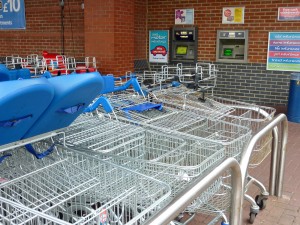 After weak Christmas trading, Tesco issued a profit warning – its first in 20 years. Following this, their shares fell in value by some £5bn, but this was met with an announcement of the creation of 20,000 jobs in the coming years, as part of a project to train staff, improve existing stores and open new ones. Yet, Tesco has reported another quarter of falling sales.
After weak Christmas trading, Tesco issued a profit warning – its first in 20 years. Following this, their shares fell in value by some £5bn, but this was met with an announcement of the creation of 20,000 jobs in the coming years, as part of a project to train staff, improve existing stores and open new ones. Yet, Tesco has reported another quarter of falling sales.
Trading times have been challenging and the fact that the UK’s biggest supermarket is struggling is only further evidence to support this. In the 13 weeks to the 26th May 2012, Tesco reported a decline in like-for-like sales of 1.5%. Although much of the £1bn investment in Tesco is yet to be spent, the fact that sales have fallen for a full year must be of concern, not only to its Chief Executive, but also to analysts considering the economic future for the UK.
Consumer confidence remains low and together with tight budgets, shoppers are continuing to be very cautious of any unnecessary spending. Part of Tesco’s recent drive to drum up sales has been better customer service and a continuing promotion war with the other supermarkets. This particular sector is highly competitive and money-off coupons and other such promotions plays a huge part in the competitive process. Whilst low prices are obviously crucial, this is one sector where non-price competition can be just as important.
Although Tesco sales in the UK have been nothing to shout about – the Chief Executive said their sales performance was ‘steady’ – its total global sales did increase by 2.2%. The Chief Executive, Mr Clarke said:
‘Internationally, like-for-like sales growth proved resilient, despite slowing economic growth in China…Against the backdrop of continued uncertainty in the eurozone, it is pleasing to see that our businesses have largely sustained their performance.’
A boost for UK sales did come with the Jubilee weekend and with the Olympics just round the corner, Tesco will be hoping for a stronger end to the year than their beginning. The following articles consider Tesco’s sales and the relative performance of the rest of the sector.
Tesco’s quarterly sales hit by ‘challenging’ trading BBC News (11/6/12)
Tesco UK arm notches up one year of falling sales Guardian, Zoe Wood (11/6/12)
Tesco upbeat despite new sales dip Independent, Peter Cripps (11/6/12)
Tesco sales seen lower in first quarter Reuters, James Davey(11/6/12)
The Week Ahead: Tesco set to admit it is losing ground to rivals Independent, Toby Green (11/6/12)
Tesco’s performance in the UK forecast to slip again Telegraph, Harry Wallop (10/6/12)
Tesco: What the analysts say Retail Week, Alex Lawson (11/6/12)
Supermarkets issue trading updates The Press Association (9/6/12)
The Week Ahead: Supermarkets prepare to give City food for thought Scotsman, Martin Flanagan (11/6/12)
Asda’s sales growth accelerates Reuters, James Davey (17/5/12)
Asda sales increase helped by Tesco Telegraph, Harry Wallop (18/5/12)
Tesco v. Sainsbury’s in trading update battle Manchester Evening News (11/6/12)
Sainsbury’s out-trades Tesco on UK food sales Independent, James Thompson (10/6/12)
Questions
- Using some examples, explain what is meant by non-price competition.
- Why has Tesco been losing ground to its competitors?
- Given the products that Tesco sells (largely necessities), why have sales been falling, despite household’s tight budgets?
- Into which market structure would you place the supermarket sector? Explain your answer by considering each of the assumptions behind the market structure you choose.
- Why have Tesco’s rivals been gaining ground on Tesco?
- How might this latest sales data affect Tesco’s share prices?
- Based on what the analysts are saying about the food sector, can we deduce anything about the future of the UK economy in the coming months?
 The Office for Budget Responsibility has said that the UK Treasury will face a shortfall of £13bn in motoring taxes within a decade. Although car usage continues to rise putting increasing pressure on the road infrastructure, the greener and more fuel efficient cars being produced are driving down the tax revenues generated from motoring.
The Office for Budget Responsibility has said that the UK Treasury will face a shortfall of £13bn in motoring taxes within a decade. Although car usage continues to rise putting increasing pressure on the road infrastructure, the greener and more fuel efficient cars being produced are driving down the tax revenues generated from motoring.
A report by the IFS has put forward the case for replacing the existing system of taxes on cars and fuel by a new road charging system. If no such change occurs, the IFS has forecast that with more electric cars and hence lower revenues raised from fuel and vehicle excise duties, the shortfall facing the Treasury would require an increase in fuel duty of some 50%. Instead of this, the solution could be to charge individuals for every mile of road they use, with the ‘price’ varying depending on the degree of congestion. For example, at peak times the price would be higher, where as for those in the countryside where roads are traditionally much quieter, charges would be lower. The IFS said:
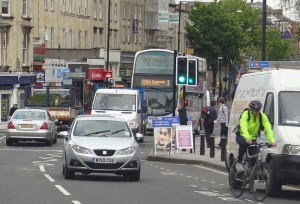 ‘Such a move would generate substantial economic efficiency gains from reduced congestion, reduce the tax levied on the majority of miles driven, leave many (particularly rural) motorists better off, and provide a stable long-term footing for motoring taxes without necessarily raising net additional revenue from drivers.’
‘Such a move would generate substantial economic efficiency gains from reduced congestion, reduce the tax levied on the majority of miles driven, leave many (particularly rural) motorists better off, and provide a stable long-term footing for motoring taxes without necessarily raising net additional revenue from drivers.’
Government policy across the world has been increasingly focused on climate change, with targets for emissions reductions being somewhat ambitious. However, many car manufactures who were told to reduce emissions significantly are on the way to meeting these targets and this success is a key factor contributing towards this new road ‘crisis’ that could soon be facing the government. The following articles consider the possibility of a road charging scheme.
Report
The road ahead for motoring taxes? Institute of Fiscal Studies (link to full report at the bottom of the page) (May 2012)
Articles
Compelling case for UK road charging, IFS study says BBC News (15/5/12)
Fears tax shortfall may lead to road tolls Sky News (15/5/12)
Who’s going to pay to update Britain’s infrastructure? Guardian Business Blog (15/5/12)
Motoring taxes: a future headache for the Chancellor Channel 4 News (15/5/12)
For whom the toll bills – less traffic hurts M6 toll road owner Guardian, Ian Griffiths and Dan Milmo (14/5/12)
Charge motorists per mile, says IFS Independent, Nigel Morris (15/5/12)
Green cars to drive down tax receipts Financial Times, Mark Odell and John Reed (15/5/12)
Questions
- Illustrate the effect of a tax being imposed on petrol. What happens to the equilibrium price and quantity?
- Despite fuel duty pushing up the price of petrol, why has there been such a small decline in the quantity of petrol individuals use?
- Evaluate the case for and against a road charging scheme.
- Why are tax revenues from motoring expected to decline over the next decade?
- Climate change has become an increasingly important focus of government policy. To what extent is the current road ‘crisis’ a positive sign that policies to tackle climate change are working?
- If a road charging scheme went ahead and prices were varied depending on traffic, time etc, what name would you give to this strategy?
- Why would it be possible to charge a higher price at peak times and a lower price for cars using country roads?
- Is there an argument for privatising the road network? Is it even possible?
 When crude oil prices go up, the prices of petrol and diesel go up pretty well straight away and by the full amount, or more, of the crude price rise. When crude prices go down, however, road fuel prices are often slow to fall; and when they do, the fall is less than the full fall in crude prices.
When crude oil prices go up, the prices of petrol and diesel go up pretty well straight away and by the full amount, or more, of the crude price rise. When crude prices go down, however, road fuel prices are often slow to fall; and when they do, the fall is less than the full fall in crude prices. Formal inquiry tries to ease motorist pain at the pumps ITV News, Laura Kuenssberg (5/9/12)
Formal inquiry tries to ease motorist pain at the pumps ITV News, Laura Kuenssberg (5/9/12)






